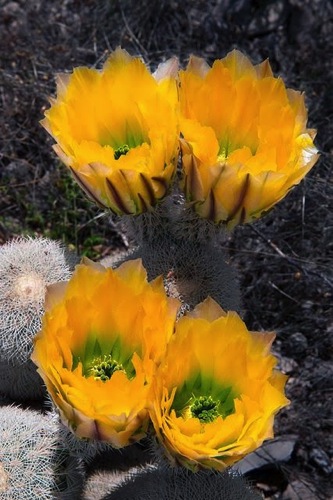Prickly Pear Cactus (Opuntia)
As a transplant from Ohio in midwestern/eastern America, cactus were very alien to me when I first moved to California. I simply hadn’t had any exposure to them. That said, I have developed an affinity for them over the years, whether in the dramatic saguaro of Arizona or our own native Opuntia or PricklyPear Cactus (La Tuña, in Spanish) They look so threatening and aggressive normally, but when it flower they have a dramatic beauty and exuberance. Even better, they produce an edible fruit and nopales (the paddle-lie stems of the cactus) are also sold as a food item here in Los Angeles. They are a bit difficult to harvest and might result in a puncture, scratch or two, but the fruit can be quite tasty.
Discovered via Tumblr user Gorgeous Flowers, Garden and Love
Opuntia is a genus in the cactus family, Cactaceae.
The most common culinary species is the Indian fig opuntia (O. ficus-indica). Most culinary uses of the term “prickly pear” refer to this species. Prickly pears are also known as tuna (fruit) or nopal (paddle, plural nopales) from the Nahuatl word nōpalli for the pads, or nostle, from the Nahuatl word nōchtli for the fruit; or paddle cactus.
The genus is named for the Ancient Greek city of Opus, where, according to Theophrastus, an edible plant grew which could be propagated by rooting its leaves.[1]
Prickly pears typically grow with flat, rounded cladodes (also called platyclades) armed with two kinds of spines; large, smooth, fixed spines and small, hairlike prickles called glochids, that easily penetrate skin and detach from the plant. Many types of prickly pears grow into dense, tangled structures.
Like all true cactus species, prickly pears are native only to the Americas, but they have been introduced to other parts of the globe. Prickly pear species are found in abundance in Mexico, especially in the central and western regions, and in the Caribbean islands (West Indies). In the United States, prickly pears are native to many areas of the arid Western United States, including the lower elevations of the Rocky Mountains, where species such as Opuntia phaeacantha and Opuntia polyacantha become dominant, and especially in the desert Southwest. Prickly pear cactus is also native to the dry sandhills and sand dunes of the East Coast from Florida to Connecticut/Long Island (Opuntia humifusa). Further north, Opuntia occurs in isolated areas from the southern Great Lakes to southern Ontario. O. humifusa is also a prominent feature of the flora at Illinois Beach State Park, in Winthrop Harbor, Illinois, north ofChicago, and of Indiana Dunes State Park southeast of Chicago. — Wikipedia.org
Previously in the Interesting Plant series:
- Campanula
- Rudbeckia
- Caladium bicolor ‘White Queen’
- Fuchsia
- Palo Verde Tree (Parkinsonia florida)
- Espalier Fruit Trees
- California Poppy (Eschscholzia californica)
- Hydrangea ‘Zorro’
- Harlequin flower (Sparaxis tricolor)
- Erythronium
- Sempervivum
- Primula auricula
- Feathery Cassia (Senna auricula)
- Red Stick Dogwood (Cornus alba ‘Sibirica’)
- Japanese Maple (Acer palmatum)
- Kousa Dogwood (Cornus kousa)
- Giant Chalk Dudleya (Dudleya brittonii)
- Sunrose (Helianthemum nummularium)
- Australian/New Zealand Tea Tree (Leptospermum scoparium)
- Brugmansia Sanguinea
- Calico Monkeyflower (Mimulus pictus)
- Colocasia Esculenta
- Acer palmatum ‘Sango-kaku’ (Coral Bark Japanese Maple)
- Linderniaceae (formerly Torenia) Kuaui Deep Blue
- Passiflora (Passion flower)
- Firewheel Tree (Stenocarpus sinuatus)
- Anemone
- Allium Cowanii
- Symphyotrichum oblongifolius (Purple Aster)
- Hemerocallis ‘Derrick Cane’ (Daylily)
- Agastache ‘Aztec Rose’
- Rudbeckia hirta Moreno
- Kalanchoe Tomentosa
- Albuca namaquensis
- Hosta ‘Remember Me’
- Dahlia ‘Clair de Lune’
- Lovely silver-tinged fern on campus of Oberlin College, Ohio
- Tricolor Beech (Fagus sylvatica Purpurea Tricolor)
- Climbing Hydrangea (Hydrangea anomala petiolaris)
- Eremurus ‘Lemon Meringue’
- Lupine “Sunrise” (Lupinus hartwegii)
- Chinese Fringe Flower (Loropetalum chinense)
- Streptocarpus ‘Harlequin Blue’
- Nigella damascena (love-in-a-mist, ragged lady)
- Epiphyllum (Orchid Cactus)
- Sempervivum ‘Westerlin’
- Gladiolus ‘Kings Lynn’
- Hosta sieboldiana ‘Dorothy Benedict’
- Begonia “Escargot”
- Asparagus Pea (Psophocarpus tetragonolobus)
- Rosa banksiae (Lady Banks’ Rose)
- Primula ‘Victoriana Silver Laced Black’
- Oxalis versicolor
- Poached Egg Plant (Limnanthes douglasii)
- Parisian Carrots
- Fritillaria imperialis Rubra Maxima
- Clematis “Fascination”
- Swiss Chard “Bright Lights”
- Georgia Rattlesnake Melon
- Dianthus Barbathus “Green Ball” or “Green Trick”
- Coleus “Religious Radish”
- Black Forest Calla Lily
- Black Bamboo
Interesting Plant is a series from A Gardener’s Notebook blog and podcast that highlights the most interesting plants I find in my Internet and real-world travels — Douglas








